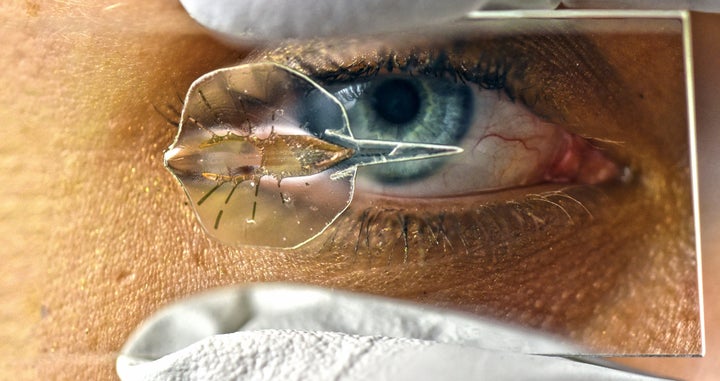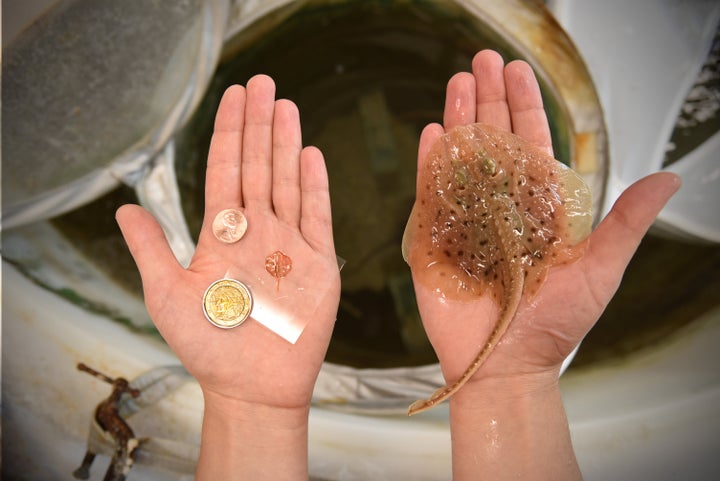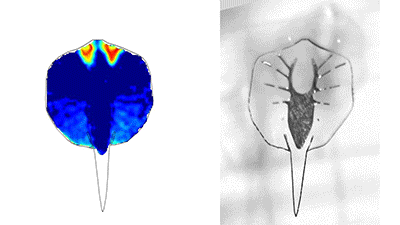
Scientists have unveiled a miniature robotic stingray the size of a toenail that sails smoothly through water, guided by pulses of light.
The bio-inspired robot is a made of a mixture of living rat heart cells and artificial material. It is only 16 millimeters long ― less than two-thirds of an inch ― and weighs just 10 grams, or a third of an ounce.
Just like stingrays and their Batoid relatives, the robot moves its flat body smoothly through water by flapping its fins in a wave-like motion. The movement of the fins is controlled by light pulses delivered to the heart muscles that line the surface of the fins.
The development of the robot ray is described in the journal Science on Thursday.

Kevin Kit Parker, an applied physicist at Harvard University who led the team of researchers, said the robot ray could interest scientists in a variety of fields ― from the cardiac physiologist interested in how the muscular architecture of the heart creates its unique pumping function, to the robotics engineer looking to use cells as a living engineering material.
Parker himself specializes in developing tiny human organs that can be used to test drug safety and efficacy. But he took a detour into robotics after a visit to an aquarium with his daughter a couple of years ago.
“The ‘eureka’ moment for the project came when my daughter Caroline and I were at the New England Aquarium,” Parker told The Huffington Post. “She was trying to pet a stingray. She put her hand in the water and the stingray quickly moved away from her hand in a very elegant way,” Parker said.
He realized he could build a system with musculature similar to cell layers of the heart. “It struck me like a thunderbolt.”
Parker and his colleagues created the robot ray out of a gold skeleton in the shape of a stingray, covered with a thin layer of flexible polymer.
Next came the brain and muscle of the ray: an orderly lined sheath of approximately 200,000 heart muscle cells, grown from a rat embryo and put on top of the robot.
To control the cells, the team turned to optogenetics, a method often used in neuroscience studies as a way to switch neurons on and off with light. Neurons or heart muscles don’t naturally respond to light. But in optogenetics, the cells are upgraded with a chunk of DNA. This special DNA codes for a protein that responds to light, rendering the cells light-sensitive.
Now, with a burst of light, the modified cells contract, sending a downward wave through the fins. When the cells relax, the robot’s skeleton pushes the fins back up.
The result is a swimming robot ray that follows the light source.

Parker notes that in this design the cells are both the sensors and actuators, which comes with benefits and disadvantages: While living muscle cells are much more energy-efficient than synthetic actuators, they are also vulnerable. And to stay alive, they need to be immersed in a warm solution with salt and sugar.
“Cells as a building material have a vote in whether or not I am going to have a good day in the lab,” Parker said. “They like to be wet, they are both robust and vulnerable, and they die.”
Applying a source of light to each fin allowed the researchers to stimulate the right or left fin and steer the robot in either direction. Different frequencies of light control how fast the fins, and hence the robot, move about.
Adam Summers, director of the Comparative Vertebrate Biomechanics Lab at the University of Washington, called the robot “a technical tour de force combining tissue engineering, robotics, organismal biology and biomechanics to yield a functional device.”
“That they got it to flap is wonderful. That they were able to steer it is nothing short of amazing,” he said.
Parker’s interest in aquatic creatures overlaps with his interest in understanding how the heart and various aspects of the anatomy help move blood in the body. And pumping and moving fluids is something marine life forms are very good at, he said.
“The idea is to get a better insight into the human heart and heart disease by reverse engineering other forms of muscular pumps that we see in nature,” he said.
This piece has been updated to include a comment from Adam Summers.
